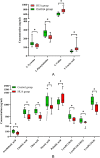Investigation of pathogenesis of hyperuricemia based on untargeted and targeted metabolomics
- PMID: 35978088
- PMCID: PMC9386008
- DOI: 10.1038/s41598-022-18361-y
Investigation of pathogenesis of hyperuricemia based on untargeted and targeted metabolomics
Abstract
Hyperuricemia (HUA) seriously harms human health but the exact etiology and pathogenesis of HUA are not fully understood. Therefore, it is still of great significance to find effective biomarkers and explore the pathogenesis of HUA. Metabolomics reflects the influence of internal and external factors on system metabolism, explains the changes in metabolite levels during the development of diseases, and reveals the molecular mechanism of pathogenesis. Metabolomics is divided into untargeted metabolomics and targeted metabolomics according to different research modes. Each other's advantages can be fully utilized by combining the two so that the results of metabolomics research can be consummated. 20 HUA patients and 20 healthy individuals participated in the experiment, and untargeted metabolomics was employed to find 50 differential metabolites in HUA serum samples. Twelve candidate biomarkers were screened based on literature research and ROC Curve analysis for subsequent verification. Based on the UPLC-TQ-MS analysis platform, the targeted metabolomics detection methods were established and the content of 12 candidate biomarkers was precisely quantified. Compare with the results of untargeted metabolomics, the targeted metabolomics results were considered more reliable.
© 2022. The Author(s).
Conflict of interest statement
The authors declare no competing interests.
Figures




Similar articles
-
High-Throughput Untargeted Serum Metabolomics Analysis of Hyperuricemia Patients by UPLC-Q-TOF/MS.Evid Based Complement Alternat Med. 2021 Jun 12;2021:5524772. doi: 10.1155/2021/5524772. eCollection 2021. Evid Based Complement Alternat Med. 2021. PMID: 34234835 Free PMC article.
-
Metabolomics approach by 1H NMR spectroscopy of serum reveals progression axes for asymptomatic hyperuricemia and gout.Arthritis Res Ther. 2018 Jun 5;20(1):111. doi: 10.1186/s13075-018-1600-5. Arthritis Res Ther. 2018. PMID: 29871692 Free PMC article.
-
Analysis of non-targeted serum metabolomics in patients with chronic kidney disease and hyperuricemia.Biotechnol Genet Eng Rev. 2024 Dec;40(4):4013-4039. doi: 10.1080/02648725.2023.2204715. Epub 2023 Apr 26. Biotechnol Genet Eng Rev. 2024. PMID: 37098873
-
Integrative metabolomics and network pharmacology to study the preventative impact of dioscin treatment on hyperuricemia.Biomed Chromatogr. 2023 Mar;37(3):e5558. doi: 10.1002/bmc.5558. Epub 2023 Jan 3. Biomed Chromatogr. 2023. PMID: 36468521 Review.
-
Mass spectrometric based approaches in urine metabolomics and biomarker discovery.Mass Spectrom Rev. 2017 Mar;36(2):115-134. doi: 10.1002/mas.21455. Epub 2015 Apr 16. Mass Spectrom Rev. 2017. PMID: 25881008 Review.
Cited by
-
Study of Plasma Biochemistry and Plasma Metabolomics Differences in Montbéliard and Holstein Backcross and Holstein Heifers.Animals (Basel). 2024 Aug 6;14(16):2294. doi: 10.3390/ani14162294. Animals (Basel). 2024. PMID: 39199828 Free PMC article.
-
Biodegradation of Uric Acid by Bacillus paramycoides-YC02.Microorganisms. 2023 Aug 2;11(8):1989. doi: 10.3390/microorganisms11081989. Microorganisms. 2023. PMID: 37630550 Free PMC article.
-
Clerodendranthus spicatus [Orthosiphon aristatus (Blume) Miq.] maintains uric acid homeostasis via regulating gut microbiota and restrains renal inflammation in hyperuricemic nephropathy.Front Pharmacol. 2024 Nov 25;15:1485861. doi: 10.3389/fphar.2024.1485861. eCollection 2024. Front Pharmacol. 2024. PMID: 39654614 Free PMC article.
-
Impact of the hemoglobin-to-red cell distribution width ratio on 30-day readmission in patients with heart failure.BMC Cardiovasc Disord. 2025 Mar 25;25(1):219. doi: 10.1186/s12872-025-04673-0. BMC Cardiovasc Disord. 2025. PMID: 40133839 Free PMC article.
-
Plantaginis Semen Ameliorates Hyperuricemia Induced by Potassium Oxonate.Int J Mol Sci. 2024 Aug 5;25(15):8548. doi: 10.3390/ijms25158548. Int J Mol Sci. 2024. PMID: 39126116 Free PMC article.
References
-
- Shi XY, Sun WF. Research progress on the related constitution of hyperuricemia. J. Mod. Integr. Chin. Western Med. 2014;23:3988–3990.
-
- Guo LX. Treatment of hyperuricemia through Chinese expert consensus about hyperuricemia anr gout treatment. Drug Eval. 2014;11:21–23+31.
-
- Li P. Research progress on epidemiology and risk factors of hyperuricemia. Contin. Med. Educ. 2017;31:93–95.
-
- Yin F, Li XC, Ye F. Hyperuricemia and metabolic syndrome: Research advances. Int. J. Pharmaceut. Res. 2017;44:487–490+499.
Publication types
MeSH terms
Substances
LinkOut - more resources
Full Text Sources

